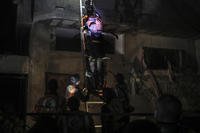
Defense Tech infrequent contributor and resident ballistics expert David Woroner busted out an interesting first-person analysis of a bullet that could answer soldiers call for more stopping power.
As our readers might remember, we reported two weeks ago that a Center for Naval Analyses study obtained by DT found of all the suggested improvements for Americas standard-issued sidearm and carbine, soldiers surveyed said they want a more deadly weapon or round.
CNA pointed out that one answer is off the table: hollow point ammo.
But Woroner took a first-hand look at a type of round that could answer a politics vs. lethality dilemma
From Dave (its a longish entry, but I think youll find it worth the read):
Known as the Federal EFMJ for expanding full metal jacket the round would appear to be a gift from above to the soldier on the ground. It is fully jacketed, yet expands like a hollow point upon impact.
The basic concept was developed by projectile whiz Tom Burzynski and Larry Head, lead ammo designer for Federal applied some of his magic to bring this bullet to fruition.
So what makes this round so different and special?
Well first of all it is a full metal jacketed bullet - this means there is no cup at the front as with most hollow points. Standard hollow points work by taking advantage of fluid dynamics - the fluid being the liquid or blood in a target.
While stopping many a fight and still not a bad choice at all, I personally have seen many hollow points stay intact - or not expand. The culprit for this has usually been, believe it or not, clothing. When the cup or hollow of the bullet is passing through clothing, especially winter type clothing the hollow point can end up filled as it cuts through the material thus preventing expansion.
Whats also pretty cool about the EFMJ bullet is that because its fully jacketed, it feeds flawlessly. Anyone whos spent some time shooting hollow-point ammo has experienced the hollow lip catching on the feed ramp of the weapon forcing an operator to execute stoppage drills in the middle of a gunfight.
Besides overcoming the feeding issue, the EFMJ works unlike a typical hollow point on impact. Think for a minute about firing at a target through drywall with a standard hollow point? Nine times out of ten the hollow point will fill up with the powdery drywall.
Now enter the EFMJ. It works by having a piece of encased lead with a tiny nylon/rubber plug. When it strikes its target, it cannot fill up at the front since its encased. Instead, it begins to (for lack of a better word) smush up the entire round. How it begins its expansion so diametrically opposed to a standard hollow point and its reliance on fluid hydraulics is that the EFMJ operates solely on impact/kinetic input to the front of the bullet.
Part of the manufacturing process of the EFMJ includes creating cuts or striations on the inside of the encasing copper. When the bullet impacts, it begins its expansion by impact/blunt force with the cuts splitting and allowing the rubber component to continue to flatten. By then it would have entered its target.
Another test I did was to shoot it through plies of standard drywall and it worked great. It penetrated, started its deformation as well. So when it struck the target behind the wall, the bullet was still full of energy, yet almost fully expanded.
Shooting through two pieces of drywall yielded the same result, except it was obvious there was a slight drop off in connecting kinetic energy. You want to be able to shoot through drywall and plywood and still hit something, but you dont want it going down the block and kill granny sitting out knitting on her front porch.
The penetration I got was very consistent with current kinetic impact understanding and that gave me even more reason to trust this round. To put it quite simply it is harder to shoot through a piece of glass then it is drywall because the glass is more molecularly compact than the drywall.
So when I shot 9mm and 45cal. rounds through each, I was pleasantly surprised to find that although the rounds did penetrate the glass, the expanded as advertised. Having my caliper in back pocket told me that the 9mm expanded to .51 inches and the 45 cal. to .64 inches (all rounds being caught by foam and soft rubber) those numbers are an average for multiple shots on glass. The 9mm in my opinion in straight up head to head performance came out ahead of the .45, Im sure only because of the higher velocity of the 9mm round.
On the drywall, I found more expansion but not by much, 9mm to .58 and the .45cal to .67 which for either surface, and the energy carried still after impact was surely enough to penetrate a solid 9-10 inches.
It would be super to see our troops carrying the EFMJ in their Beretta, Colt, Kimber, etc. The next thing Federal needs to do is create the same technology in the 5.56 (.223) round, I would be very interested to see the results of that test.








